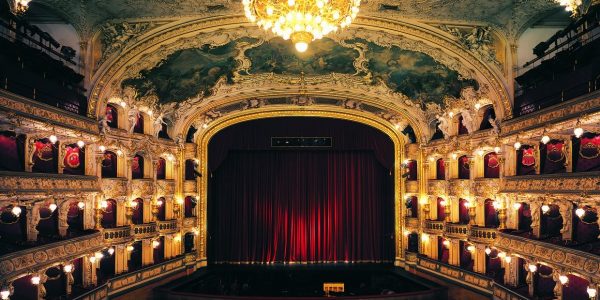Gershwin’s Compositional Style
Born in Brooklyn to an immigrant parent from Russia, George Gershwin began his musical journey at an early age. His love for music led him to drop out of school to work for Jerome H. Remick & Co, a music publishing firm on Tin Pan Alley. Gershwin composed his first major work, “Rhapsody in blue” around 1924. He travelled to Paris the following year to study composition with Nadia Boulanger, but was rejected due to his jazz-influenced style. Gershwin was greatly influenced by Ravel’s compositional style: he developed his own style in an attempt to adapt to the diverse American society. He expands the use of blue note by lowering the third and seventh degree in his composition and uses syncopated rhythms as a driving tool. His blend of French style with America’s cultural influence make his compositions widely recognized around the world.[1]
The rise of Broadway theatre in the early 20th century attracted Gershwin, and he returned to the United States to begin composing for various film companies. His original scores for film include: Delicious, The Goldwyn Follies, The Shocking Miss Pilgrim, Shall We Dance, and A Damsel in Distress. Gershwin’s embrace of the piano as a rhythmic instrument transformed his popular compositional style. Gershwin’s rhythmic styles blended with his stylistic nuances to make his composition unique among his contemporaries. Most of his musicals were originally composed for piano and later set into songs by his brother Ira. His brother was also responsible for the libretto to George’s opera, Porgy and Bess and other Broadway musicals.[2]
As music evolved through the Renaissance, to the 21st century, each period had its own characteristics that shaped the compositional style of the era. Different composers from the same time period have different compositional styles. For example, Bach’s harmonic progressions tend to be dense when compared to Handel’s light progression. These two composers maintain the free counterpoint style of the Baroque period. The first Viennese composers Haydn, Beethoven, and Mozart have also maintained the compositional style of the classical period, which includes short motivic idea and the development of a structured allegro-sonata form. Mozart’s style often sees the use of trills at a cadencial point, while Beethoven always outlined an appregaited note while approaching a cadence. Gershwin’s style of Broadway musical composition is easy to sing to and his melody defies his contemporaries’ style, which are only meant to be sung by skilled musicians. His approach includes the use of American folk tunes. Though Gershwin died at the young age of thirty-eight, his contribution to classical orchestration and Broadway theatre have enriched millions of people at bridging the gap between classical and popular music.[3]
Aina Olonade
Bibliography
Hans Keller. “Gershwin’s Genius.” The Musical Times 103, no. 1437 (1962): 763-64. doi:10.2307/950772.
Neimoyer, Susan. “After the Rhapsody: George Gershwin in the Spring of 1924.” The Journal of Musicology 31, no. 1 (2014): 91-138. doi:10.1525/jm.2014.31.1.91.
Schneider, Wayne J., Norbert Carnovale, and Richard Crawford. “Gershwin, George.” Grove Music Online. 25 Jan. 2018.
[1] Schneider, Wayne J., Norbert Carnovale, and Richard Crawford. “Gershwin, George.” Grove Music Online. 25 Jan. 2018.
[2] Hans Keller. “Gershwin’s Genius.” The Musical Times 103, no. 1437 (1962): 763-64. doi:10.2307/950772.
[3] Neimoyer, Susan. “After the Rhapsody: George Gershwin in the Spring of 1924.” The Journal of Musicology 31, no. 1 (2014): 91-138. doi:10.1525/jm.2014.31.1.91.
